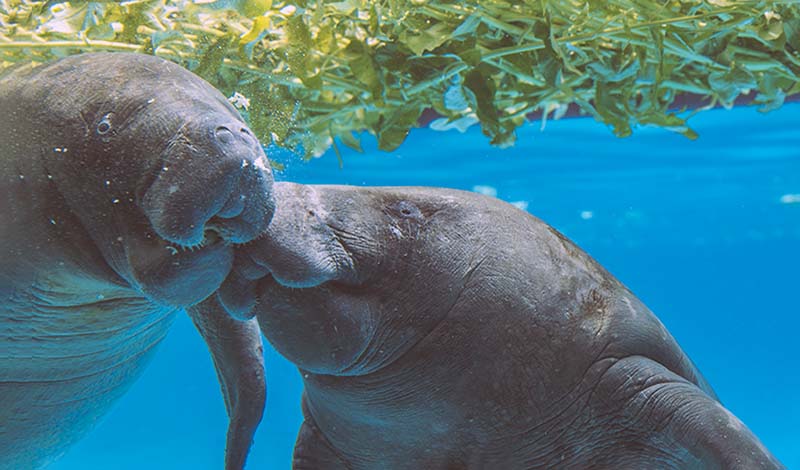2-minute read
That wonderfully evocative quote from Ralph Waldo Emerson serves as a joyful reminder to get out there and cultivate some blooming laughs this spring. In celebration of Earth Month, we’re re-posting our April 2021 blog; it’s chock-full of resources to help you plan and grow a mood-lifting Smile Machine. So dig in and share a bit of green good cheer with people, wildlife, and the planet!
After you’ve planted your patch, if you’re feeling extra motivated, you can earn climate-friendly rewards for giving Mama Earth a boost this month. Check it out!

In the race to protect and restore the rapidly dwindling natural world, we humans occupy the space between hope and healing, and we have the power to make that space both beautiful and life-sustaining. If you are an aspiring citizen conservationist motivated to show our home planet a little love in honor of Earth Month, you may be surprised (and excited!) to learn that one of the most impactful contributions that you can make to support nature is to turn your backyard into a haven for wildlife. By tending to your outdoor patch in a way that increases native species, contributing to both biodiversity and your local green infrastructure, you can help to shape healthy, stable ecosystems that support all living beings.
The good news is you don’t need to be an expert in horticulture or wildlife biology to nurture nature and become a champion for green connectivity—the linking of natural areas so that animals can safely move from one place to another. Wherever you are, city or suburb, and whatever the size of your outdoor space, you can create habitat stepping stones for birds, pollinators, and other wild ones. It all comes down to what you grow because what you grow determines which species can live on your patch. By learning which native plants are the best choices to support wildlife, you can help prevent the loss of precious flora and fauna and the resulting disruption of ecosystems. Over the last 50 years, biological diversity has diminished by 68% globally, and 1,000,000 species are currently at risk of extinction. Now, more than ever, it’s all green thumbs on deck.
To guide the transformation of your backyard, patio, or terrace garden into a wildlife-supporting habitat, we’ve pulled together some useful resources to get you growing in April:
Nature’s Best Hope/Douglas W. Tallamy: A New York Times Bestseller, Nature’s Best Hope offers engaging, expert insight into the need for and benefits of backyard conservation, the specialized relationship between plants and animals, as well as an easy-to-follow blueprint for choosing plants that increase biodiversity. It also features helpful FAQs such as why Monarch caterpillars only eat milkweed and why you should care that birds are disappearing—for the bird-indifferent.
The Wildlife Gardener/Kate Bradbury: This photo-filled gardening guide details step-by-step projects to help you bring nature home.
National Wildlife Federation Native Plant Finder: Just enter your North American zip code into this handy tool to find out which plants host the highest number of butterflies, moths, and birds in the place where you live.
National Wildlife Federation Certified Wildlife Habitat Program: If you’ve decided to go all-in, you can have your garden officially certified as a habitat for wildlife. Fill out this application to let NWF know about your sustainable practices and how you provide food, water, cover, and places to raise young.
Audubon Native Plant Finder: The National Audubon Society offers another excellent location-specific planting tool. Enter your zip code into the Native Plant Finder to receive an emailed list of the best plants for your local birds, get tips on how to create a bird-friendly habitat, and track your contribution to Audubon’s goal of planting 1 million native plants for feathered friends.
Monarch Watch: A non-profit conservation, education and research organization dedicated to the preservation of the Monarch butterfly, Monarch Watch offers free milkweed plants to create a Monarch waystation, as well as tips on how to grow milkweed and monitor caterpillar growth.
Prairie Moon Nursery: This is one of our favorite native plant nurseries and the largest in the United States. With over 700 plants in stock, if you need it, they probably have it, including keystone plants like asters, milkweed, goldenrod, and sunflowers to get you started. And they are staffed by lovely, knowledgeable people to boot!
We hope that you’re feeling at least a bit inspired to dig in and explore ways that you can participate in the backyard biodiversity movement. By pitching in to nurture rather than diminish nature, we can help keep the planet that we depend on for survival functioning in top form, and that’s a wonderful and necessary thing. Grow native and they will come!
Happy gardening! Wishing every bunny a peaceful holiday!
































































